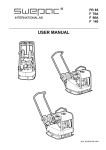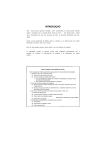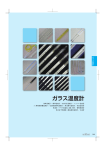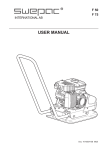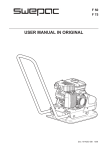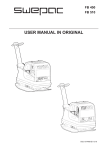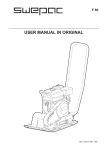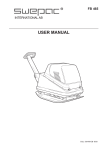Download User manual
Transcript
FB135 FB145 FB200 FB200E FB200H USER MANUAL Dok: 101482B-GB 0641 Dok: 101482B-GB 0641 FB 135 / FB 145 / FB 200 / FB 200E / FB 200H 2 FB 135 / FB 145 / FB 200 / FB 200E / FB 200H USE SWEPAC FB 135 / FB 145 / FB 200 / FB 200E / FB 200H are used to pack ballast under foundations, in connection with road building, in trenches, etc. On account of the forward/reverse function, the machine is very suitable for packing in tight spaces and as a complement to larger packing equipment in places with poor access CONTENTS USE ..........................................................................3 SAFETY INSTRUCTIONS .....................................4 STANDARDS ..........................................................4 SIGNS ......................................................................5 TECHNICAL DATA ................................................6 METHOD OF OPERATION ...................................6 TECHNICAL DESCRIPTION ................................7 DAILY CHECKS .....................................................8 BEFORE STARTING ..............................................9 STARTING, petrol engine .......................................9 AFTER STARTING.................................................9 STOPPING ..............................................................9 BEFORE STARTING ............................................10 STARTING, diesel engine .....................................10 AFTER STARTING...............................................10 STOPPING ............................................................10 Dok: 101482B-GB 0641 OPERATING INSTRUCTIONS ...........................11 TRANSPORTATION .............................................11 3 FB 135 / FB 145 / FB 200 / FB 200E / FB 200H SAFETY INSTRUCTIONS STANDARDS • Before using the machine, the operator must be informed of the manufacturer’s safety instructions and instructions for use. Noise Measurement in accordance with the standard EN 500-4 Rev. 1:1998, Annex C: • The machine may only be used outdoors. In accordance with the conditions in Directive 2000/14/EC, Annex VI, the following values are reported: • The machine may not be used if protection and safety devices are not present or not working. • The operator may not leave the machine unattended when the engine is on. When the vibrator is connected, the operator must be able to control the movement of the machine using the control handle and the start/stop controls. The machine may be operated only by a trained operator. • During maintenance work or other interventions in the machine, the engine must always be off. • Switch the engine off before adding fuel. Avoid fuel spillage and immediately wipe off any spilled fuel. Add fuel only in well ventilated areas. • Avoid touching hot engine parts, for example the silencer. • Before lifting the machine, check that the lifting device and its mounting are not damaged and that the rubber dampers on the base plate are undamaged and tightened. • During transportation and storage, the fuel tank should be empty and the fuel cock switched off. • When the machine is parked, ensure that it cannot tip over. The machine may not incline more than 20º. • The operator must use ear protectors when working with the machine. Sound pressure level at the operator’s ears, LpA 91 dB (A) 93 dB (A) 95 dB (A) 91 dB (A) Permitted sound power level, L WA 108 dB (A) 108 dB (A) 108 dB (A) 108 dB (A) Guaranteed sound power level, L WA 106 dB (A) 108 dB (A) 108 dB (A) 104 dB (A) As the sound pressure level at the operator’s ears exceeds 85 dB (A), ear protectors must be used during operation! Hand/arm vibrations The vibration acceleration was measured in accordance with the ISO 5349 standard during operation on a surface of macadam. The measurement values were translated into the maximum daily exposure time for regular usage. For additional information about vibrations, please confer the regulation AFS 2005:15 from the Swedish Work Environment Authority, effective July 1st 2005. FB 135 FB 145 FB 200/E FB 200H Hand/arm vibrations, m/s2 2,7 3,1 2,7 2,5 The maximum daily exposure time 6,9 h 5,2 h 6,9 h 8h Exhaust Emissions The FB 135 and FB 200H meet the requirements for exhaust emissions in accordance with EU Directive 2002/88EC stage 2. The FB 145, FB 200 and FB 200E meet the requirements for exhaust emissions in accordance with US-CARB stage 1. Dok: 101482B-GB 0641 • The operator must ensure that no unauthorised persons are in the immediate vicinity of the machine. FB 135 FB 145 FB 200/E FB 200H 4 FB 135 / FB 145 / FB 200 / FB 200E / FB 200H SIGNS Warning Signs Machine Signs 1 2 3 4 8 Before use, carefully read the manual and its safety instructions so that you can handle the machine safely. Ensure that the manual is always accessible. 5 7 1. 2. 3. 4. 5. 6. 7. 8. 6 Manufacturer Place, country of manufacture. CE mark. Model name. Year of manufacture. Max. engine power. Max. weight. Serial number. Engine and silencer: to avoid burns or discomfort, do not touch hot engine parts when the engine is on or when the machine has recently been used. Dok: 101482B-GB 0641 Belt drive: Keep hands, tools and other objects away from the belt drive when the machine is on to avoid injury and damage. See the safety instructions in the manual. As the sound pressure level at the operator’s ears exceeds 85 dB (A), ear protectors must be used when working with the machine to prevent hearing damage. 5 FB 135 / FB 145 / FB 200 / FB 200E / FB 200H TECHNICAL DATA FB 145 Net weight .................................142 kg Base plate, w x l ........................430 x 660 mm Speed ........................................approximately 25 m/min Permitted inclination ................20° Centrifugal force .......................27,000 N Vibration frequency ..................87 Hz Drive engine ..............................Honda GX 160 Engine power ............................4 kW Engine RPM .............................3250 RPM Fuel tank volume.......................3.6 liter Fuel type....................................Unleaded petrol, 95-98 octane Oil quantity, crankcase ..............0.6 litres Net weight .................................153 kg Base plate, w x l ........................430 x 660 mm Speed .........................................approximately 25 m/min Permitted inclination .................20º Centrifugal force .......................27,000 N Vibration frequency ..................87 Hz Drive engine ..............................Yanmar L48AE Engine power ............................3.5 kW Engine RPM .............................3250 RPM Fuel tank volume.......................2.5 liter Fuel type....................................Diesel Oil quantity, crankcase ..............0.8 liter FB 200 FB 200H Net weight .................................203 kg Base plate, w x l ........................480 x 730 mm Speed .........................................approximately 25 m/min Permitted inclination .................20º Centrifugal force .......................31,000 N Vibration frequency ..................83 Hz Drive engine ..............................Yanmar L60AE Engine power ............................4 kW Engine RPM ..............................3250 RPM Fuel tank volume.......................3.5 liter Fuel type....................................Diesel Oil quantity, crankcase ..............1.1 litres Net weight .................................200 kg Base plate, w x l ........................480 x 730 mm Speed .........................................approximately 25 m/min Permitted inclination .................20º Centrifugal force .......................31,000 N Vibration frequency ..................83 Hz Drive engine ..............................Honda GX 200 Engine power ............................4.8 kW Engine RPM ..............................3500 RPM Fuel tank volume.......................3.6 liter Fuel type....................................Unleaded petrol, 95-98 octane Oil quantity, crankcase ..............0.6 litres FB 200E METHOD OF OPERATION Net weight .................................215 kg Base plate, w x l ........................480 x 730 mm Speed .........................................approximately 25 m/min Permitted inclination .................20º Centrifugal force .......................31,000 N Vibration frequency ..................83 Hz Drive engine ..............................Yanmar L70AE Engine power ............................4.9 kW Engine RPM ..............................3250 RPM Fuel tank volume.......................3.5 liter Fuel type....................................Diesel Oil quantity, crankcase ..............1.1 litres The machine consists of a base plate with a vibration element and an upper part cushioned from the base plate. The cushioning between the base plate and the upper part consists of rubber dampers. The power is transmitted from the engine to the vibration element via a V-belt which can be adjusted with a belt tensioner. The engine V-belt pulley is fitted with an integrated centrifugal clutch, which allows the engine to be started and run idle without the vibrator being connected. The engine is well protected against damage in connection with use and transportation by a sturdy protective frame with a protective panel on the top. Dok: 101482B-GB 0641 FB 135 6 FB 135 / FB 145 / FB 200 / FB 200E / FB 200H TECHNICAL DESCRIPTION FB 135 / FB 200H 1 2 3 12 4 5 11 10 9 Control handle Forward/reverse control Lifting eye Centrifugal clutch V-belt Vibration element Base plate Rubber damper Engine plate Petrol engine Transport locking device Throttle lever 1. 2. 3. 4. 5. 6. 7. 8. 9. 10. 11. 12. Control handle Forward/reverse control Lifting eye Centrifugal clutch V-belt Vibration element Base plate Rubber damper Engine plate Diesel engine Transport locking device Throttle lever 6 7 8 1. 2. 3. 4. 5. 6. 7. 8. 9. 10. 11. 12. FB 145 / FB 200 / FB 200E 1 2 3 12 4 5 11 9 8 7 6 Dok: 101482B-GB 0641 10 7 FB 135 / FB 145 / FB 200 / FB 200E / FB 200H DAILY CHECKS Oil/Fuel Leakage Fuel Check Check that there is fuel in the tank. Top up if necessary. Engine Oil Level Check Check the oil level in the crankcase every day. The oil must reach the edge of the filling hole when the machine is on a level surface. Check every day that the engine is not leaking oil or fuel. If a leak is discovered, the machine may not be operated until the fault has been remedied.avhjälpts. Hydraulic Oil Level Check Check every day that the hydraulic connections do not leak or wear during operation. Check the oil level with the dipstick on the top of the tank. The level must be between “MIN” and “MAX”. Air Filter Check The air filter must be checked at least once every working week. When working in dusty conditions, check daily. Honda 1 2 1. Paper element 2. Foam plastic element Rubber Dampers Check the condition of the rubber dampers regularly. Replace damaged dampers. 2 1 Cleaning 1. Remove the foam plastic element and the paper element and check that they are undamaged. Replace damaged parts. 2. Wash the foam plastic element in liquid with a high flashpoint and let it dry properly. Dip in engine oil and squeeze dry. 3. Strike the paper element against a hard object a few times to loosen any dirt. 8 Polyuretan Pad A polyuretan pad is used for stone paving work to protect against stones and ground clinker. FUEL and OIL RECOMMENDATIONS Fuel (petrol engine) ...........Unleaded petrol or alkylate -”- (diesel engine) .....Diesel Engine oil ..........................SAE 10W-30 Hydraulic oil ....................Viscosity Grade ISO VG 22 Dok: 101482B-GB 0641 Yanmar V-belt Drive Check the tension and condition of the V-belt regularly. Replace a damaged V-belt with the new type B 32 for FB 135, FB 200H and B 34 for FB 145, FB 200E and FB 200. FB 135 / FB 145 / FB 200 / FB 200E / FB 200H Off On Oil level Off On Engine power switch Open Closed Fuel cock Choke BEFORE STARTING AFTER STARTING See Daily Checks on page 8. Switch the throttle lever to idle. STARTING – Petrol Engine, FB 135 and FB 200H Throttle lever Open the choke gradually. Run the engine warm for around 5 minutes. Switch the engine power switch to “on”. Open the fuel cock. Switch the throttle lever to “MIN”. Adjust the choke. If the engine is cold, close the choke completely. Do not use the choke if the engine is warm or if the air temperature is high. Switch the engine to idle and let it run for a few minutes. Switch the engine power switch to “off”. Close the fuel cock. Dok: 101482B-GB 0641 Start by pulling the starting handle. Pull it first until the mechanism engages. Then pull it hard and fast. STOPPING 9 FB 135 / FB 145 / FB 200 / FB 200E / FB 200H On Closed Off Open Fuel cock Engine power switch Decompression handle Charging lamp and start switch Throttle lever BEFORE STARTING Manual Starting - FB 145 and FB 200 See Daily Checks on page 8. Open the fuel cock. Switch the throttle lever to “MIN”. Switch the throttle lever to “MIN”. Open the fuel cock. Switch the engine power switch to “on”. The charging control lamp lights up. Start the engine using the starter switch. Note! Never run the starter motor for longer than 10 seconds at a time. If the engine does not start, wait 15 seconds before trying to start it again. In very cold weather or if the battery capacity is low for a different reason, starting can be facilitated using the decompression device in connection with the valve housing. Press the lever down and hold it down until the flywheel has reached its maximum RPM. Then let it go. Pull the starter cord as far as it will go. Let the cord go back in. Press the decompression handle down. The handle must remain in the depressed position. Take hold of the starter cord with both hands and pull hard. AFTER STARTING Switch the throttle lever to the idle position “MIN”. Run the engine warm for around 5 minutes. STOPPING Switch the engine to the idle position “MIN”, let it run for a few minutes, then switch it to “O”. Never switch the engine off with the decompression handle. Switch the engine power switch to “off” (electric starter). Close the fuel cock. 10 Dok: 101482B-GB 0641 STARTING – Diesel Engine, FB 200E (Electrical Starter) FB 135 / FB 145 / FB 200 / FB 200E / FB 200H OPERATING INSTRUCTIONS TRANSPORTATION The machine’s vibration elements start when the throttle is increased. The best packing is achieved at full engine RPM (“MAX”). Avoid running the engine at other RPM. The machine’s vibration element stops when the throttle lever is switched to idle. The machine has a lifting eye that can be used for a hook or hawser. To move forwards, do not touch the forward/reverse control. To reverse, pull the hoop towards the control handle. Moving forwards Reversing The machine is only designed to be used outdoors. Work with the machine in daylight or other adequate lighting. Ballast must be wetted or naturally damp. All other use is discouraged. Check before lifting that the lifting eye and its mounting on the machine are undamaged. Check also that the base plate’s rubber dampers are undamaged and firmly attached. For transportation by vehicle, the handle must be folded forwards and locked with the transport locking device. The machine must then be secured with, for example, approved straps. Note! Secure it by the base plate and not the rubbercushioned upper part. Dok: 101482B-GB 0641 Note! When moving up a slope, the machine should be reversed. The machine may not incline more than 20º when in use or parked. 11 SWEPAC INTERNATIONAL AB Address Box 132, 341 23 Ljungby, Sweden, tel. +46 (0)372-156 00, fax +46 (0)372-837 41, E-mail [email protected], Internet www.swepac.se












